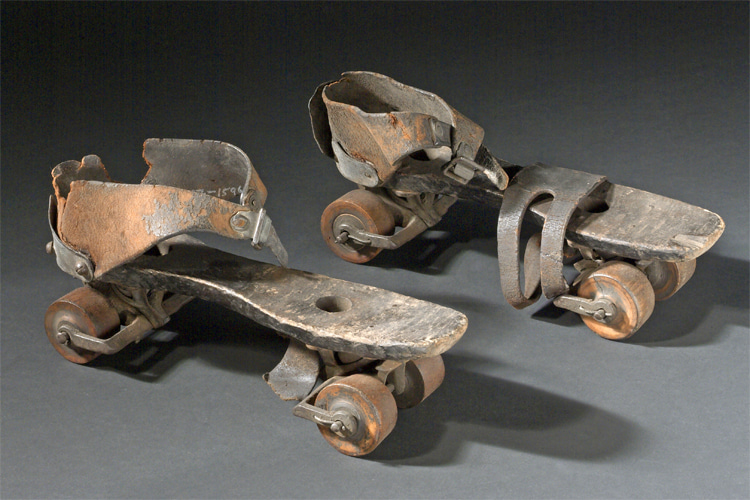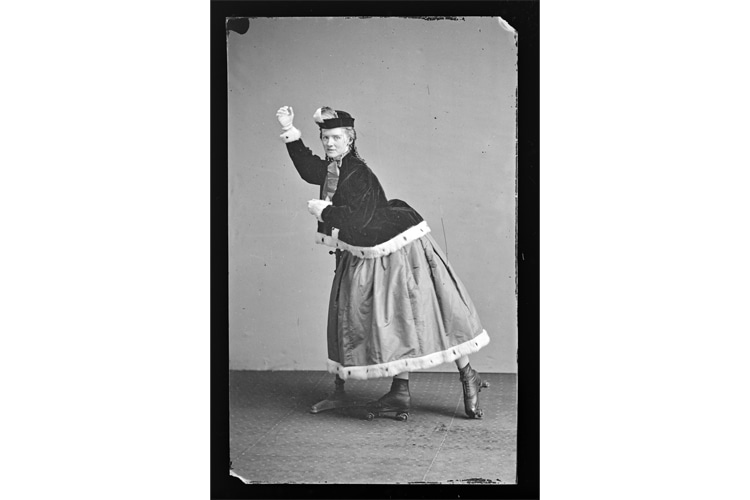How roller skates influenced the creation of skateboards

Skateboarding is a relatively recent outdoor activity, pastime, and sport. Although its roots are deeply attached to mid-20th-century California surfing, the skateboard DNA reveals a connection to a recreational activity born 200 years before in Europe.
The history of skateboarding, as well as the personalities who contributed to the invention and birth of the skateboard, are well documented.
Interestingly, though, there's usually an undervalued contribution that goes a long way back in time.
No, we're not taking you all the way to somewhere between 4,500 and 400 BC, when the early signs and versions of the wheel took shape.
Our main focus is on the invention of roller skates, a pair of transportation and leisure items that were developed in the 18th century.
To be fair, the skateboard owes as much to the lack of waves in Southern California as to roller skates.
Let's not forget skateboards evolved from these contraptions installed under our feet into milk crates or wooden boxes with wheels attached to them and handles sticking out for control before morphing into the modern skateboard shape.
In other words, roller skates paved the way for products like Kne-Koster (1925), Scooter Skate (1930s), Flexy-Racer (1932), and Skeeter Skater (1945), before the popular flat-deck-and-wheels design.
So, what exactly are the origins of roller skates?

Made for Arts
One of the first surprising things about roller skates, the predecessor of the skateboard, is that they were originally aimed at the performing arts world.
It was not a physical exercise novelty equipment.
According to historians, the earliest models were used in European theater and musical events to simulate ice skating onstage, an activity with over 4,000 years of history in southern Finland.
However, these roller skating appearances were rare because the first models made turning or curving nearly impossible.
Therefore, actors, actresses, and performers could only ride in a straight line.
It would take a century to see relevant improvements and updates to the equipment and, consequently, a spread in popularity.
Broken Mirror: The Disastrous Debut
As with skateboards and other sports gear, roller skates result from several incremental iterations.
Researchers point out that the first report of the use of wheeled skates took place in 1743 on a London stage.
However, the first recorded invention dates from 1760.
It was introduced by John Joseph Merlin, an inventor, musical instrument maker, and clockmaker from Liège, Belgium.
The tale behind Merlin's innovative roller skates is quite funny.
The story goes that the Belgian inventor made an unforgettable yet disastrous debut of his invention.
He showcased his skates at a high-society event hosted by Teresa Cornelys at Carlisle House in Soho Square, London.
During this demonstration, Merlin tried to impress the audience by skating around while playing a violin.
However, the skates, which lacked any kind of steering or braking system, proved difficult to control.
"Although well-known as an inventor and musician, Joseph Merlin was not a good skater, notes James Turner, author of the book "The History of Roller Skating."
"He couldn't control his speed or command his skates to go in the desired direction, and wildly crash-landed into a huge and expensive mirror [£500 value[, smashed it to bits, severely wounded himself, broke his violin and sent roller skating technique back to the drawing board."
Sadly, Merlin's written records had no drawings nor descriptions of wheel configurations.
The First Patent
The second of three important roller skate iterations happened on November 12, 1819, when Charles-Louis Petibled, a French inventor, filed the first-ever patent for roller skates.
He called them "land skates" and designed them to replicate ice skating moves indoors, allowing skaters to mimic gliding and maneuvering on solid ground.
Petibled's skates featured a wooden or metal sole mounted onto a boot or secured with straps.
The wheels - made from materials like metal, wood, or even ivory - were arranged in an inline configuration.
The design allowed for some degree of movement but had significant limitations, making tight turns or advanced maneuvers difficult.
The number and size of the wheels were flexible, with some models including three wheels with or without grooves.
Notably, Petibled incorporated a basic braking mechanism: a screw placed under the heel.
The skates' components, including cleats and axles, were constructed from sturdy materials like steel and riveted securely to the base.
Though primitive, this design laid the groundwork for modern roller skates.
The Defining Iteration
The last of three critical improvements arrived half a century later.
John Joseph Merlin's contribution to the birth of roller skates is undeniable.
However, it was American inventor James Leonard Plimpton who gave them safety and easy-to-use properties.
The patent Plimpton registered in 1863, a century after Merlin's creation, allowed riders to steer by leaning to the right and left.
They were called "rocker skates."
The four-wheel setup, also called "quad skates," featured independent axles for easy turning in a smooth arc and truly ignited a revolution.
Although his roller skates marked a significant breakthrough in the evolution of roller skating, a major issue persisted: the wheels wore out quickly due to substantial friction between the wheels and the skate axle.
Plimpton addressed this problem by introducing a brass ring positioned between the wheel and the axle.
To further reduce wear and tear, he applied lubrication to this brass "skate bearing."
Soon, roller skating rinks were popping up in New York and then expanding to other cities in America, Europe, and worldwide.
Merlin also founded the first roller skating club for gentlemen to impress the ladies.
In the venue, riders had to follow proper rules of etiquette and could have lessons to learn and improve their skills.
James Plimpton's roller skate design is still pretty much similar to the one used today.
His innovations also served as the inspiration for the creation of the skateboard and skateboarding roughly 100 years later.
Words by Luís MP | Founder of SurferToday.com
